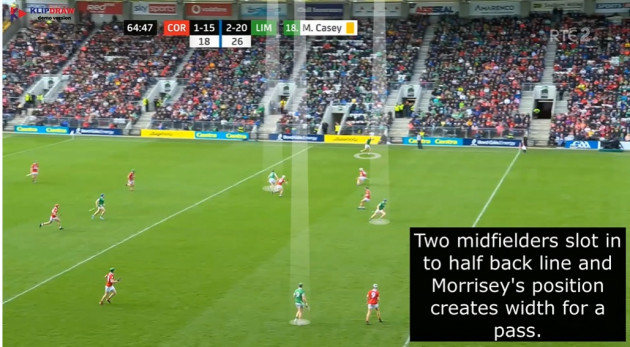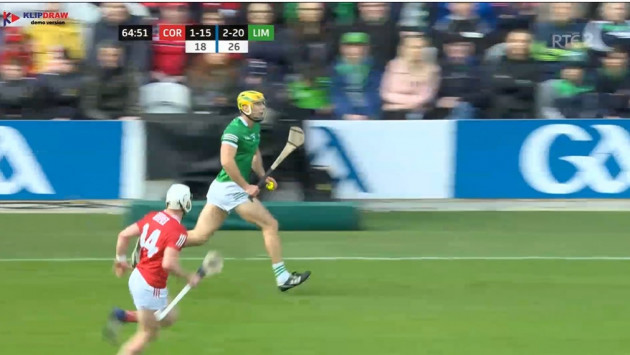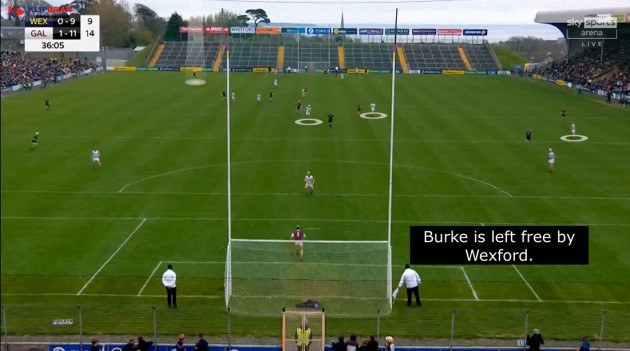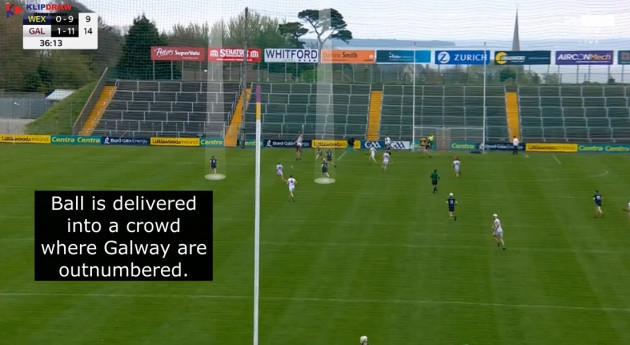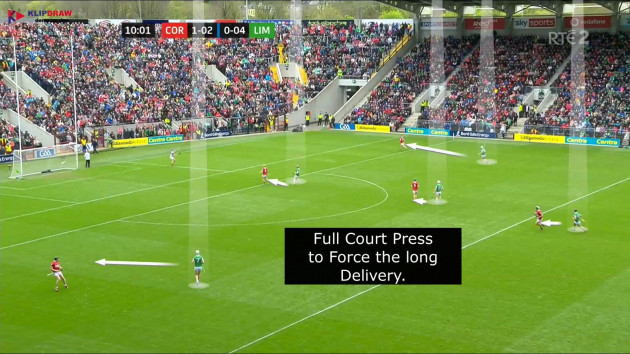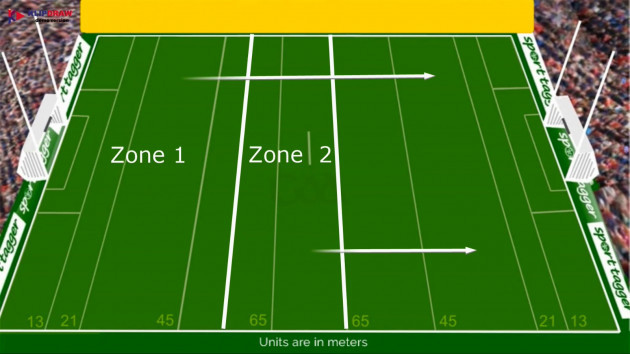OF ALL THE facets of the modern game that raise the ire of crowds, nothing generates a collective groan like a short puck-out.
From the televised games last weekend between Wexford v Galway, Waterford v Tipperary and Cork v Limerick, there were 91 short puck-outs.
As a coach and analyst, I analyse the efficiency of a team’s short puck out by checking if the restart resulted in possession being retained in the opposition’s half of the pitch.
From the three televised games, 33 of the 91 short puck outs resulted in possession in the opposition’s half of the pitch which was a 36% retention rate.
Limerick operating at another level
(Team – no. short POs – Short PO resulting in possession in opp’s half – percentage)- Limerick – 18 – 13 – 72%
- Wexford – 14 – 5 – 36%
- Tipperary – 18 – 6 – 33%
- Waterford – 12 – 3 – 25%
- Cork – 23 – 5 – 21%
- Galway – 11 – 1 – 9%
Stats Sean Flynn
Limerick worked 13 out of their 18 short restarts out of their defence against Cork which resulted in five points for John Kiely’s side. Often, the detail of Paul Kinnerk was obvious as they had four players in their full-back line, four in their half-back line with one wing forward coming into midfield as a potential out ball.
The All-Ireland champions were able to use a mix of accurate restarts by Nickie Quaid, the overload of four players in their full-back line and four players in the half-back line allowed them to move the ball around their half and establish a platform to hit their forwards.
This was aided by Cork’s passive attitude when it came to tracking runs in the middle third of the pitch. This issue was particularly obvious in the lead up to Cathal O’Neill’s point in the 64th minute.
Clever Wexford vs Galway’s route one
When we compare this to the lack of innovation in Galway’s short puck-outs against Wexford in the Leinster championship, their issue is glaring. The Tribesmen retained just one from their eleven short puck-outs in the Wexford half of the pitch.
These figures are in part due to Darragh Egan’s tactic of sitting off the Galway puck-out, as their full-forward line withdraws and packs the middle third of the pitch.
An example of this was in the second half where there was no movement from the Galway half-backs or midfield which forced Daithi Burke to give the ball back to Eanna Murphy to launch long into the full-forward line.
Here you can see Wexford drop an extra man in front of Conor Whelan (top corner.)
Tipperary discomfort with the short puck-out
Tipperary conceded 1-2 (5) from their short puck-out in their own third on Sunday. Some of the short puck-outs resulted in huge pressure on the Tipperary backs and ended up in crucial scores being conceded. To put the concession of 1-2 (5) in one game into perspective, there was one point conceded from the short puck-out being turned over in their own third in 20 games during the 2021 hurling championship.
Cork’s short puck-out malfunction
A feature of Cork’s play in 2021 was their use of the short option and 25% of the Rebel’s scores originated from a short puck-out in the championship. Limerick shut down the Rebel’s short restart and only 10% of their scores came off their short puck-out in Sunday’s game. Limerick used a full-court press on the Cork puck-out. With awesome tackle technique, they were able to turn the Cork defenders back towards their own goal like a good greyhound turning the hare.
Limerick playing a different game
There are many sayings to describe how teams use the ball in the modern game. Terms such as ‘playing the ball through the lines, possession game and tippy-tappy hurling’ can cause great debate amongst hurling fans.
They can generally be split into two camps. There is the supporter who craves first-time hurling which would serve up exciting tennis games like Tipperary and Kilkenny in 2009, 2010 and 2011. Alternatively, there is a supporter who accepts the modern game of hurling and the rationale as to why teams need to deliver the ball higher up the pitch into their forward line.
The use of the ball is another area that really shows how Limerick are playing a different game to that of the other five teams that were televised last weekend.
When analysing the delivery of possession, I break the team’s delivery zone into two parts. Zone one is from a team’s goals to the area halfway between their 45 and 65-metre line. Zone two is the top half of the area between their 45 and 65-metre line to the opposition’s 65-metre line.
From analysing over 80 inter-county hurling games, the retention rate of deliveries into the opposition’s half from zone 1 would average at 38%. The retention rate of deliveries into the opposition’s half from zone 2 would average at 66%.
So, some inter-county managers are encouraging their players to bring the ball higher up the pitch into zone 2 to deliver the ball in order to retain possession in the opposition’s half of the pitch.
What sets Limerick apart is not the retention rate of their deliveries, but their ability to work the ball into zone 2 and deliver quality ball to their forwards. John Kiely’s men retained possession from 69% of their deliveries that they hit into the opposition’s half of the pitch against Cork.
The key ingredients for their ability to work the ball are built on their coaching of the stick pass, movement off the ball to create a line of sight, width, shape, creation of space in the inside forward line and the pace at which the ball is played into the forwards.
*****
Number of deliveries from Zone 1 – Retention rate in opposition’s half
- Limerick – 9 – 66%
- Cork – 11 – 36%
- Waterford – 15 – 47%
- Tipperary – 19 – 32%
- Wexford – 22 – 23%
- Galway – 25 – 24%
Number of deliveries from Zone 2 – Retention rate in opposition’s half
- Limerick – 26 – 69%
- Cork – 14 – 71%
- Waterford – 10 – 80%
- Tipperary – 16 – 96%
- Wexford – 13 – 54%
- Galway – 10 – 80%
*****
The increased use of the ball from zone 1 which would be classed as a long delivery will often result in the concession of more scores from turnovers from play. If we look at the number of turnovers conceded and compare it with the teams who deliver more from zone 1 it will show how it can affect a team on the scoreboard.
A comparison of this would be between Limerick and Tipperary over the weekend’s games. Limerick conceded 0-7 from turnovers against Cork while Tipperary who hit 19 deliveries from zone 1 conceded 1-15 (0-18) from turnovers in the middle and Waterford’s third of the pitch.
Early Days
These trends are over one round of three games and could never be an accurate reflection of each team. The class of Limerick was on show once more last weekend, yet another timely warning for any team who hope to take Liam MacCarthy off them.


